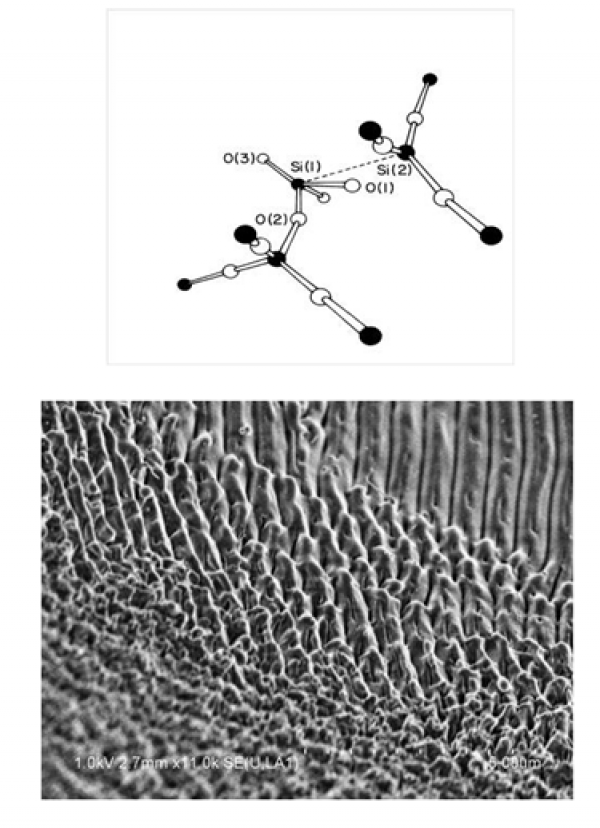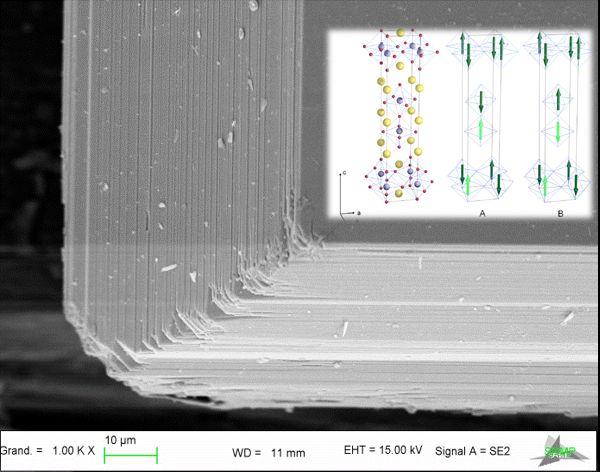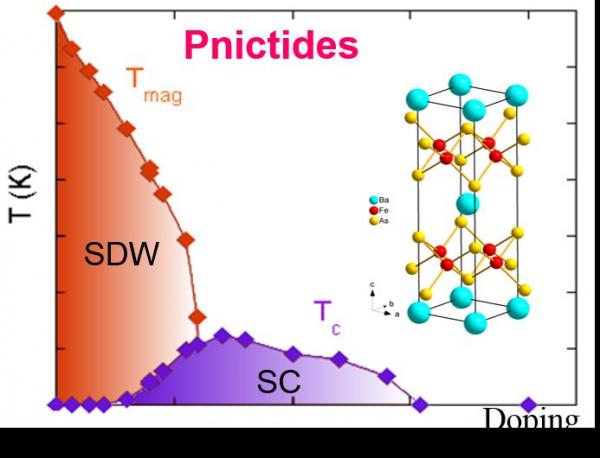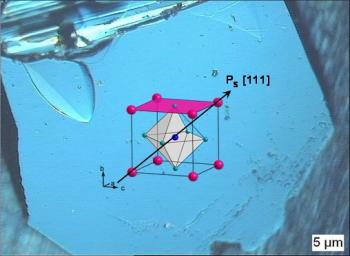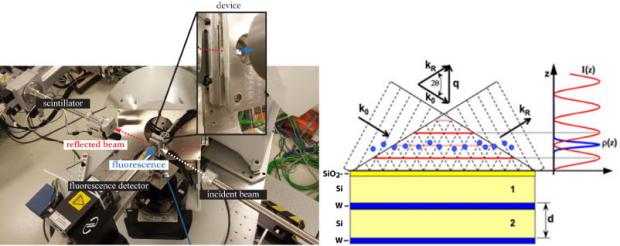Pages scientifiques 2016
Superfluid helium droplets provide an ideal environment for spectroscopic studies with rotational resolution. Nevertheless, the molecular rotation is hindered because the embedded molecules are surrounded by a non-superfluid component. The present work explores the dynamical role of this component in the hindered rotation of C2H2 within the C2H2–Ne complex. A HENDI experiment was built and near-infrared spectroscopy of C2H2–Ne and C2H2 was performed in the spectral region overlapping the ν3/ν2 + ν4 + ν5 Fermi-type resonance of C2H2. The comparison between measured and simulated spectra helped to address the above issue.
Solar energy conversion is today a fact. Traditionally dominated by crystalline silicone, new alternative technologies are emerging, in particular based on organic photovoltaics (OPV), hybrid solar cells (dye-sensitized solar cells) or new inorganic materials such as perovskites and nanomaterials. The efficiency of a photo-active material depends on the charge separation process that is itself largely dependent on the structural properties of the material. Charge carriers can be trapped and other competing non-radiative relaxation processes may decrease the efficiency. The initial processes preceding the charge separation are studied in DICO using time-resolved spectroscopy.
This topic is being developed in two directions :
2. Hybrid organic-inorganic structures
Dye Sensitized Solar Cells, also known as Grätzel cells, are very promising owing to their potential efficiency as well as being cheap. However, further improvements are necessary, particularly on the photocathode side. This requires a more detailed understanding of the molecular and electronic dynamics. To this purpose we have undertaken a study of the photophysics and the primary processes occurring after light absorption using femtosecond luminescence up-conversion (project funded by the CEA programme DSM Energy).
A PhD student, Valentin Maffeis, co-directed by Drs. Thomas Gustavsson and Bruno Jousselme (DRF/IRAMIS/NIMBE/LICSEN) is working on this subject (2015-2018).
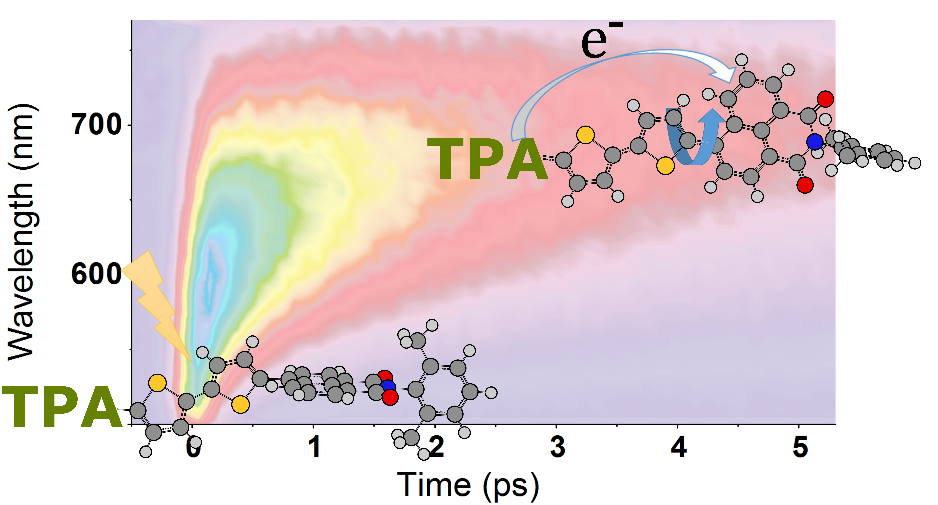
Figure 1. Time-resolved fluorescence spectra of a new push-pull type molecule I solution. The excited charge transfer state formed by light absorption is strongly stabilized by the polar environment. The charge separation (and ultimately, the charge injection) occurring in the excited state is in dynamic competition with the energy stabilization which leads towards a non-radiative internal conversion (leading to electron back transfer). It is therefore important to characterize the different processes involved in order to optimize the "wanted" reaction paths (charge separation) with regards to the "unwanted" reaction paths (internal conversion).
Hybrid organic-inorganic structures are a new class of materials that combine the advantages of organic and inorganic systems. Among these materials, hybrid perovskites are currently attracting an enormous interest. This new research program aims to examine in detail the ultrafast photophysical processes occurring in hybrid perovskites using the combination of femtosecond luminescence up-conversion and two-dimensional (2D) electronic spectroscopy. This project is supported by an ANR ACHN grant (2016-2019) coordinated by Elsa Cassette.
A PhD student, Carolina Villamil-Franco, co-directed by Drs. Thomas Gustavsson and Elsa Cassette is working on this subject (2017-2020).
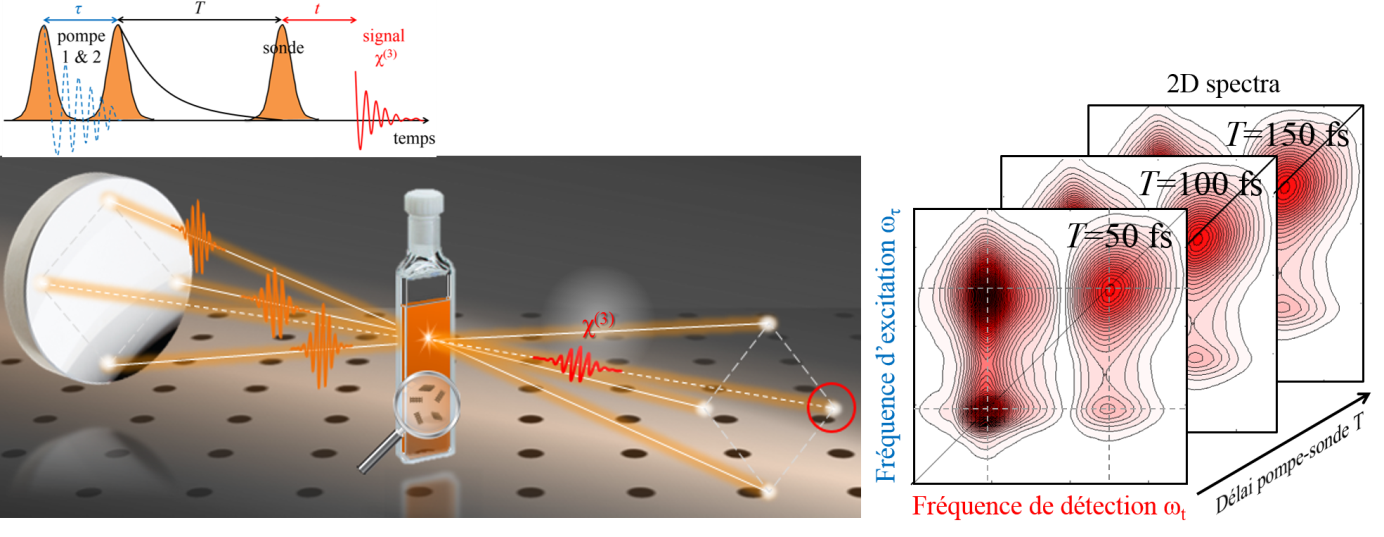
Figure 2. Principle and schematic view of a two-dimensional (2D) electronic spectroscopy measurement in the "boxcar" configuration. Also shown are typical "2D-plots" correlating the excitation and detection frequencies, showing the presence of off-diagonal coupling terms.
Nous étudions les processus d’excitation et de relaxation électronique dans les solides excités par une impulsion laser ultra-courte et intense.
Les matériaux étudiés sont essentiellement les diélectriques à large bande interdite, soit pour leur importance dans les applications telle que l’optique ou l’électronique (SiO2, Al2O3, Diamant, MgO, CdWO4), soit pour leur intérêt fondamental (Diamant, Halogénures d’alcalins).
Les processus physiques étudiés vont de la formation des défauts ponctuels, au claquage optique, en passant par les effets de forte densité d’excitation tels que l’interaction entre excitons dans les scintillateurs.
Approche expérimentale : suivre l’évolution de la matière en temps réel
Les lasers délivrant des impulsions ultra brèves sont un outil expérimental unique pour étudier les solides. Ils présentent un double intérêt :
- générer une forte densité d’excitation dans les solides, de façon contrôlée,
- permettre les expériences résolues en temps de type pompe et sonde avec différentes techniques de diagnostique : interférométrie, absorption, réflectivité, photoémission à deux impulsions, etc…, et ainsi résoudre la dynamique des processus d’excitation et de relaxation.
Des défauts ponctuels au claquage optique : suivant les éclairements utilisés, les lasers femtosecondes permettent d’étudier une large gamme de phénomènes, qui vont de la formation des défauts ponctuels : à gauche, modèle d’exciton auto piégé dans le quartz, jusqu’au claquage optique : ici image MEB d’un cratère d’ablation dans α-SiO2.
Balcerzyk A, Baldacchino G.
Implementation of laser induced fluorescence in a pulse radiolysis experiment - a new way to analyze resazurin-like reduction mechanisms
Analyst. 2014;139:1707-12.
Balcerzyk A, Boughattas I, Pin S, Balanzat E, Baldacchino G.
First observation of HO reactivity in water under high energy ions at elevated temperature
PCCP. 2014;16:23975-84.
Baldacchino G.
Water radiolysis with heavy-ion beams at GANIL. Back to 20 years of investigations
Journal of Physics: Conference Series. 2015;629(1):012009.
Baldacchino G, Katsumura Y.
Chemical processes in heavy ions track.
In: Rao BSM, Wishart JF, editors. Recent Trends in Radiation Chemistry. Singapore: World Scientific Publishing Co. Pte. Ltd.; 2010. p. 231-54.
Baldacchino G, Maeyama T, Yamashita S, Taguchi M, Kimura A, Katsumura Y, et al.
Determination of the time-dependent OH-yield by using fluorescent probe. Application to heavy ion irradiation
Chem Phys Lett. 2009;468(4-6):275-9.
El Omar AK, Baldacchino G, Monnet I, Bouniol P.
Revisited water radiolysis at elevated pH by accounting O3[radical dot]- kinetics at low and high LET.
RSC Advances. 2015;5(108):89244-53.
Karamitros M, Luan S, Bernal MA, Allison J, Baldacchino G, Davidkova M, et al.
Diffusion-controlled reactions modeling in Geant4-DNA. Journal of Computational Physics
2014;274(0):841-82.
Lin M, Muroya Y, Baldacchino G, Katsumura Y.
Radiolysis of Supercritical Water
In: Rao BSM, Wishart JF, editors, Recent Trends in Radiation Chemistry 2010.
Nguyen Le DT, Pin S, Anjoure D, Chopineau P, Baldacchino G.
Design of a high pressure system for pulse radiolysis studies up to 400MPa with flow
Nucl Instrum Meth in Phys Res B. 2013;299:1-7.
Sicard-Roselli C, Brun E, Gilles M, Baldacchino G, Kelsey C, McQuaid H, et al.
A new mechanism for hydroxyl radical production in irradiated nanoparticle solutions.
Small. 2014;10(16):3338-46.
Yamashita S, Baldacchino G, Maeyama T, Taguchi M, Muroya Y, Lin MZ, et al.
Mechanism of radiation-induced reactions in aqueous solution of coumarin-3-carboxylic acid: Effects of concentration, gas and additive on fluorescent product yield.
Free Radic Res. 2012;46(7):861-71.
Yamashita S, Taguchi M, Baldacchino G, Katsumura Y.
Radiation Chemistry of Liquid Water with Heavy Ions: Steady-States and Pulse Radiolysis Studies.
In: Hatano Y, Katsumura Y, Mozumder A, editors. Charged Particle and Photon Interactions with Matter Recent Advances, Applications, and Interfaces. Boca Raton: CRC Press, Taylor and Francis Group; 2011. p. 325-54.
The iridates (eg Sr2IrO4, Sr3Ir2O7 ...) have recently attracted the attention of the scientific community due to the presence of a strong spin-orbit coupling and strong electronic interactions that give rise to original physical properties as the high Tc superconductivity or the state of topological insulator. We explore in detail the impact of a strong spin-orbit coupling in these compounds by synthesizing single crystals with a method of self-flow and thin films by PLD technique and by studying the magnetic and transport properties of these oxides.
On these issues, the group has developed national and international collaborations in particular with: LPS-Orsay; Soleil; MPQ-Paris7; LLB-Saclay ;
Contact CEA-IRAMIS/SPEC : Dorothée Colson (SPEC/LNO)
Projects: SOCRATE (ANR 2015-2019)
Superconductivity is a fascinating state of matter in which electric current flows without dissipation of energy. For thirty years, the search for high-temperature superconductors focused on cuprates, however, the origin of the pairing mechanism is not yet clear because of the high structural and electronic complexity of these materials. To study the properties of high Tc superconductors, the sample quality is a crucial element. One of the strengths of the group is to be able to implement various advanced techniques to synthesize ceramics or single crystals cuprates, including mercury cuprates of the highest Tc of (135K, or -138 ° C) at ambient pressure but also new iron pnictides. These pure or substituted compounds, including cuprates are actively elaborated and studied to capture the main features of the electron pairing mechanism.
On these issues, the group has developed national and international collaborations in particular with: LPS-Orsay; Soleil; MPQ-Paris7; ESPCI-Paris; LSI-Palaiseau; ESRF-Grenoble; Institut Néel-Grenoble; Université de Sherbrooke (Canada); IFW Dresden (Allemagne); Université de Victoria (Nouvelle Zélande)…
Contact: Dorothée Colson
Regarding multiferroic oxides, the group has developed very resistive crystals that have enabled to demonstrate, for the first time, the multiferroic character at room temperature of the BiFeO3 compound and determine a very high electric polarization value (P> 100 μC / cm 2 >> 25 μC / cm2, reference value of the barium titanate, ferroelectric BaTiO3). In collaboration, a coupling between magnetism and electric polarization at room temperature was highlighted as well as other properties quite amazing as the coupling between light and deformation etc... [cf. publications + faits marquants]… Because of these couplings, this type of multifunctional materials offer the ability to switch, under the action of an external signal of a particular kind (light, stress, external magnetic field or electric), property of different type of material (magnetization, electric polarization, deformation ...). All these couplings in the same material, opens the way to designing a wide variety of sensors with amazing potential applications.
On these issues, the group has developed national and international collaborations in particular with: LPS-Orsay; Soleil; MPQ-Paris7; LLB-Saclay ; UMR-Thalès-Palaiseau ; IPCMS Strasbourg…
Contact: Dorothée Colson
NEW! Internship Position (French M2 level) Open
Together with the researchers from LEDNA/IRAMIS, we are seeking a motivated candidate for an 4-5 months internship project on:
Thermally Charging Ionic SuperCapacitor with Vertically Aligned Carbon NanoTube Electrodes
Interested candidates are invited to read the project description (click on the title above) and contact: sawako.nakamae@cea.fr
Concept
The thermoelectric effect (the Seebeck effect) describes a material’s intrinsic property to directly convert temperature difference (ΔT) applied across its body into electric voltage (ΔV) and vice-versa;
ΔV = -SeΔT (1),
where Se is “the Seebeck coefficient.” TE-generators can be used to recover waste-heat from various sources; e.g., body heat, car exhausts, industrial waste streams, solar heating, etc., to generate electricity. Conversely, the application of voltage ΔV results in a temperature difference (the Peltier effect) such that the same material can be used as a TE-cooler.
The thermoelectric effect also exists in liquids, although the physical origins of induced electrical potential are quite different. Unlike in solid TE materials, where either the electrons or the holes carry electricity, there are multiple number of 'charged' species in liquid electrolytes and complex fluids that can act as both charge and heat carriers. The thermoelectric voltage and current generation in complex fluids (such as charged colloidal suspensions, ionic liquids, etc.) can be attributed to 3 main physical phenomena; which are; a) Thermogalvanic effect b) thermodiffusion of charged species (ions and/or charged molecules and particles) and c) Selective ion attachments of ionic species (electronic double layer) to the hot and cold electrodes (see figure below).
- Thermogalvanic effect: Today, the thermoelectric applications of liquid electrolytes are predominantly focused on thermogalvanic cells, also known as ‘thermoelectrochemical cells,’ or simply ‘thermocells,’ where redox molecules reversibly exchange electrons (oxidation-reduction mechanism) with cell electrodes to produce large reaction entropy change leading to a thermogalvanic-voltage.
The most well-known example of thermocells is that of aqueous potassium ferro/ferricyanide redox solutions. Here, the redox molecules reversibly exchange electrons with thermocell’s electrodes to produce a large reaction entropy change leading to a thermovoltage (Eq. 3) of the order 1 mV/K [18], i.e.,
(3),
where ΔSAB is the partial molar entropy change of the redox reaction, n is the number of electrons transferred in the reaction and F is Faraday constant.
- Thermodiffusion effect: The TE-effect in complex liquids (electrolytes, ionic liquids, colloidal solutions etc.) is further coupled to the movement of dissolved charged species (ions, molecules or colloidal particles) and is closely related to the “Soret effect” which describes the concentration gradients, ni induced under a temperature gradient;
(Δni/ni ) = αiΔT (4).
The Soret effect or “thermophoresis” has been extensively studied during the last decades (see for example [19] [20] [21]) and is often used for microfluidic characterization and separation. The Soret coefficient, a, is generally proportional to the entropy transported by the moving molecules or particles (i.e., internal degrees of freedom, large solvation shell, particle/molecule size, etc.). Therefore, large thermoelectric coefficients can be expected in complex liquids exhibiting large values of a. Curiously, the corresponding thermoelectric effect has so far attracted much less attention.
Background
The distribution of ions and charges at solid-water interfaces is of key importance in a number of phenomena and processes. In particular the development of micro- and nano-fluidics has strengthened the need for characterizing, understanding, modeling and controlling ion distributions in the electric double layer [1]. Indeed, surface driven transport phenomena such as electro-osmosis or electrophoresis are sensitive to charge distribution, and phenomena occurring within the diffuse Gouy-Chapman layer become dominant in determining flow properties as channel size, Debye length and slip length become on the same order of magnitude, leading to unusual phenomena [2]. With charged walls, channels can be filled with a unipolar solution of counter-ions, suggesting that the type and concentration of ions can be controlled by the surface charge density of the channel wall [3]. Here, specific effects (size, polarisability, hydration of the ions) could allow for even finer control over the ion type [4].
[1] L. Bocquet and E. Charlaix. Chemical Society Reviews, 39:1073–1095, 2010.
[2] Q.S. Pu, J.S. Yun, H. Temkin, and S.R. Liu. Nanoletters, 4:1099–1103, 2004.
[3] R. Karnik, R. Fan, M. Yue, D.Y. Li, P.D. Yang, and A Majumdar. Nanoletters, 5:943–948, 2005.
[4] Ion-specific anomalous electrokinetic effects in hydrophobic nanochannels,
D.-M. Huang, C. Cottin-Bizonne, C. Ybert, and L. Bocquet. Physical Review Letters, 98 (2007) 177801.
La protection et la conservation des objets du patrimoine culturel (archéologiques, musée, monuments, statuaire, …) est un enjeu sociétal majeur. Ceux-ci subissent des altérations dues aux interactions avec l’environnement. C’est tout particulièrement le cas des métaux (fer - acier, cuivres - bronzes, plomb, etc) qui se corrodent. Cette altération peut avoir lieu dès leur abandon mais également lors de leur exposition au public. La mise en place de traitements efficaces de restauration et de protection est alors cruciale. Or, ceux-ci ne peuvent être de simples transpositions de solutions utilisées dans l’industrie des traitements anticorrosion. En effet, il existe pour le patrimoine des exigences spécifiques de préservation de l’aspect des objets lors du traitement et de réversibilité des revêtements appliqués. De plus ces systèmes de long terme ont des spécificités physico-chimiques (hétérogénéité, réactivité,…). Ainsi, tant les traitements de restauration, que les revêtements de protection, doivent faire l’objet de recherches adaptées mettant en jeu des techniques de caractérisation multi-échelle et des tests représentatifs des conditions d’utilisation.
La société A-CORROS est spécialisée dans la mise en œuvre et le développement de ces traitements. Elle a mis au point un prototype unique en Europe, de déchloruration, étape essentielle de traitement des métaux archéologiques, par voie subcritique. Une fois opérationnel, ce protocole réduira de plusieurs ordres de grandeur les temps de traitements, avec des conséquences économiques majeures pour la restauration des objets archéologiques métalliques. Avant de passer à une phase d’exploitation commerciale, ce nouveau procédé nécessite cependant des recherches approfondies sur l’évolution de la structure et de la texture des produits de corrosion au cours du traitement afin d’en assurer la reproductibilité et la fiabilité.
Par ailleurs, A-CORROS, comme l’ensemble des acteurs du patrimoine, utilise un certain nombre de revêtements de protection qu’elle met en œuvre sur les objets de grandes dimensions exposés, notamment en plein air. Ces traitements, actuellement basés sur l’utilisation de cires microcristallines ou d’inhibiteurs de corrosion sont d’une efficacité limitée dans le temps. Ainsi, une action de R&D afin de comprendre les mécanismes d’action de ces composés et d’optimiser leur fonction de neutralisation des zones réactives au sein des produits de corrosion poreux tout en répondant aux critères du patrimoine serait cruciale en ce domaine.












